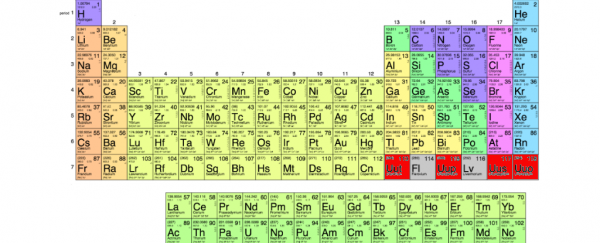Officials from the International Union of Pure and Applied Chemistry (IUPAC) have confirmed the discovery of elements 113, 115, 117, and 118, announcing that there is now enough evidence to give them permanent places on the periodic table, which means they'll also need new, official names.
You won't find these four elements in nature - they are synthetic elements that can only be produced in the lab, and because they decay in a matter of seconds, their existence has been extremely difficult to confirm. Until now, elements 113, 115, 117, and 118 had temporary names and positions on the seventh row of the periodic table because scientists have struggled to create them more than once.
"For over seven years we continued to search for data conclusively identifying element 113, but we just never saw another event," Kosuke Morita from RIKEN in Japan said of one of the four elements. "I was not prepared to give up, however, as I believed that one day, if we persevered, luck would fall upon us again."
Morita's team has been credited with the confirmed discovery of element 113, which means they've won the naming rights too. Until now, the element been known by the temporary name, ununtrium, and temporary symbol Uut.
The three remaining elements, 115, 117, and 118 - known temporarily as ununpentium (Uup), ununseptium (Uus), and ununoctium (Uuo), respectively - will also get new names.
The IUPAC has announced that a team of US and Russian researchers have fulfilled the criteria for proving the existence of the remaining three elements, 115, 117, and 118, and will be invited to propose permanent names and symbols. They have been temporarily known as ununpentium (Uup), ununseptium (Uus), and ununoctium (Uuo), respectively.
"The chemistry community is eager to see its most cherished table finally being completed down to the seventh row," Jan Reedijk, president of the Inorganic Chemistry Division of IUPAC, said last week.
The organisation advises that the new elements can be named after a mythological concept, a mineral, a place or country, a property, or a scientist, and will be presented for public review for five months before a final decision about the new official name and symbol is made.
While reports on the confirmation of elements 115, 117, and 118 are yet to be published, details of element 113's discovery have been reported in the Journal of Physical Society of Japan.
The RIKEN researchers describe how in 2003, they began bombarding a thin layer of bismuth with zinc ions travelling at about 10 percent the speed of light, and according to theory, the reaction should occasionally produce an atom of element 113.
In 2004 and 2005, the team saw signs of dubnium-262 (element 105), which is believed to be the decay product of element 113, but this was not enough evidence to prove its existence.
"[T]he group performed a new experiment, where a sodium beam was collided with a curium target, creating borhium-266 and its daughter nucleus, dubnium-262," explains a press release. "With this demonstration, the grounds for a stronger claim were laid. They just needed to wait to see an atom decaying through the alpha chain rather than spontaneous fission."
It wasn't until 2012 that the team achieved this, and it took almost four years for the IUPAC to wade through the scientific literature and confirm that the evidence met their criteria for the discovery of elements.
"Now that we have conclusively demonstrated the existence of element 113," says lead RIKEN researcher, Kosuke Morita, "we plan to look to the uncharted territory of element 119 and beyond, aiming to examine the chemical properties of the elements in the seventh and eighth rows of the periodic table, and someday to discover the Island of Stability."
We can't wait to see what the new names will be.
